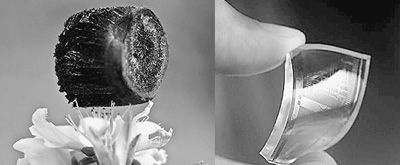Monolayer graphite is a very magic material, it can be conductive, and its strength is more than a hundred times that of steel. However, recent tests by scientists on single-layered graphite samples show that although this material may be the toughest material present today, it is also very fragile, just like ceramics. why? The reason is that it is easy to break.

Graphite (profile)
A team of scientists from Rice University and the Georgia Institute of Technology in the United States tested small pieces of "double-layered" graphite - two sheets of pure carbon, equivalent to single atom thickness, stacked on top of one another. Scientists use a cluster of ion beams to irradiate them so that they produce tiny cracks. This graphite was then dragged and twisted to observe the rate of expansion of these fractures until the material finally broke.
“Single-layer graphite is very sensitive to the presence of cracks. In contrast, if there is a small crack in the steel, it is not particularly dangerous. Steel has a huge resistance to crack expansion. Single-layer graphite is more like a window glass.†The chief author and Ting Zhu, an associate professor of mechanical engineering at Georgia Institute of Technology, said.
The ability of a material to resist cracking, that is, fracture toughness, includes not only the tensile strength—that is, the probability of the material breaking when it is stretched. It also measures when a specific material is distorted. , the "punishment" it can tolerate before it breaks. For example, the metal is malleable. You need to twist and bend it repeatedly to break a spoon. The glass is resistant to distortion, but it is not ductile, so if the twisting force or stretching force exceeds a certain limit, it will break rapidly. Even a small crack is enough to cause the glass to crack.
A study conducted by Professor Zhu and Jun Lou of Rice University found that cracked single-layer graphite is 10 times more likely to fracture than steel, and its fracture toughness is closer to that of aluminum oxide or silicon carbide. Base ceramics. The relatively low fracture toughness means that a small crack in a single layer of graphite is enough to destroy it. Such a small crack is likely to be a natural result of the manufacture of graphite.
Graphite can be produced in several ways, including chemical vapor deposition, which is the gradual cooling of carbon vapor and the presence of carbon atoms on the surface, and exfoliation, that is, the removal of graphite from a single layer of graphite into a solvent. The graphite layer produced by the first method can be large but not perfect. The lattice of carbon atoms produced by this method has a small defect—a single atom may be missing everywhere. If monolayer graphite is used as a conductor or a semiconductor, this defect does not have much impact. However, if used for mechanical applications, such as the manufacture of flexible displays or to enhance the structural strength of other materials, the impact of such defects can not be ignored.
The perfect single-layer graphite can withstand 100 gigapascals of pressure before breaking, approximately equivalent to 1,000,000 times atmospheric pressure. However, defective single-layer graphite has a breaking strength of only about one in 100,000 times. It can only withstand a pressure of 4 MPa, which is 40 times the standard atmospheric pressure. This experiment is not only important for the study of single-layer graphite, it may provide a very important reference for other studies, because other two-dimensional structural materials may also have similar characteristics. "The modeling used in this study may be used to study other 2D materials such as aluminum disulfide or boron nitride," Professor Zhu said. The study was published in the April 29 issue of Nature Communications.
Emergency Light,Emergency Light Led,Led Emergency Bulb,Led Emergency Light
Jiangmen Duramp Electric Co., Ltd , https://www.durampled.com